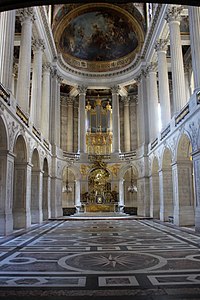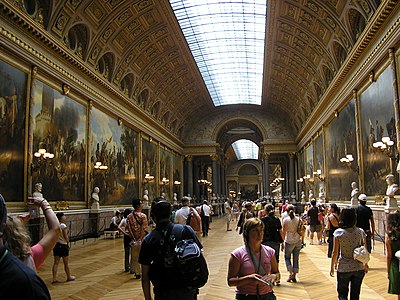Palace of Versailles
| Palace of Versailles | |
|---|---|
Château de Versailles | |
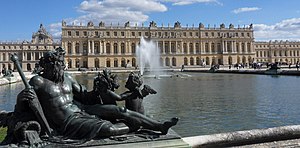 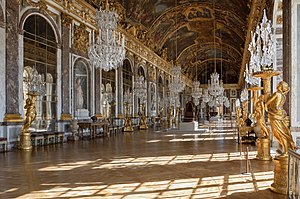 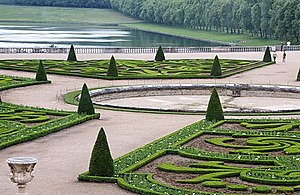 Garden facade; Hall of Mirrors; Gardens of Versailles | |
| General information | |
| Location | Versailles, France |
| Coordinates | 48°48′17″N 2°07′13″E / 48.8048°N 2.1203°E / 48.8048; 2.1203Coordinates: 48°48′17″N 2°07′13″E / 48.8048°N 2.1203°E / 48.8048; 2.1203 |
| Technical details | |
| Floor area | 67,000 m² (721,182 ft²) |
| Website | |
| Official site of the Château de Versailles | |
| UNESCO World Heritage site | |
| Official name | Palace and Park of Versailles |
| Criteria | Cultural: i, ii, vi |
| Reference | 83 |
| Inscription | 1979 (3rd Session) |
| Area | 1,070 ha |
| Buffer zone | 9,467 ha |
The Palace of Versailles (French: Château de Versailles; English: /vɛərˈsaɪ, vɜːr-/ vair-SY, vur-;[1]French: [vɛʁsaj]) was the principal royal residence of France from 1682 under Louis XIV until the start of the French Revolution in 1789 under Louis XVI. It is located in the department of Yvelines, in the region of Île-de-France, about 20 kilometres (12 miles) southwest of the centre of Paris.[2]
The palace is now a Monument historique and UNESCO World Heritage site, notable especially for the ceremonial Hall of Mirrors, the jewel-like Royal Opera, and the royal apartments; for the more intimate royal residences, the Grand Trianon and Petit Trianon located within the park; the small rustic Hameau (Hamlet) created for Marie Antoinette; and the vast Gardens of Versailles with fountains, canals, and geometric flower beds and groves, laid out by André le Nôtre. The Palace was stripped of all its furnishings after the French Revolution, but many pieces have been returned and many of the palace rooms have been restored.
In 2017 the Palace of Versailles received 7,700,000 visitors, making it the second-most visited monument in the Île-de-France region, just behind the Louvre and ahead of the Eiffel Tower.[3]
Contents
1 History
1.1 The hunting lodge and château of Louis XIII
1.2 The palace of Louis XIV
1.3 Enlargement of the Palace (1678-1715)
1.4 The Palace of Louis XV
1.5 Louis XVI, and the Palace during the Revolution
1.6 19th century - history museum and government venue
1.7 20th century
1.8 21st century
2 Ownership and management
3 Architecture and plan
4 Royal Apartments
4.1 The State Apartments of the King
4.1.1 The Salon of Hercules
4.1.2 The Salon of Abundance
4.1.3 The Salon of Venus
4.1.4 The Salon of Mercury
4.1.5 The Salon of Mars
4.1.6 The Salon of Apollo
4.1.7 The Salon of Diana
4.2 Private apartments of the King and Queen
4.2.1 Private apartments of the King
4.2.2 Private apartments of The Queen
5 The Grand Gallery
5.1 The War Salon
5.2 The Hall of Mirrors
5.3 The Peace Salon
6 Royal Chapel
7 Royal Opera
8 Museum of the History of France
9 Gardens and fountains
9.1 The Parterre d'Eau and the Parterre and Fountain of Latona
9.2 Fountain of the Chariot of Apollo and the Grand Canal
9.3 North Parterre, Dragon Basin, and Basin of Neptune
9.4 South Parterre and the Orangerie
9.5 The Fountains and the Shortage of Water
10 The Bosquets or Groves
11 The Grand Trianon and Petit Trianon
12 The Hamlet of Marie Antoinette
13 Modern Political and ceremonial functions
14 Cost
15 In popular culture
16 Gallery
17 See also
18 Notes
19 References
19.1 Footnotes
19.2 Works cited
20 External links
History
The hunting lodge and château of Louis XIII

The garden facade of the chateau of Louis XIII in 1660-64. (Engraving by Israël Silvestre)

The palace in 1668 during the first reconstruction. (Painting by Pierre Patel)

The facade of the palace facing the garden in 1675. The terrace was replaced by the Hall of Mirrors
The site of the Palace was first occupied by a small village and church, surrounded by forests filled with abundant game. It was owned by the Gondi family and the priory of Saint Julian. King Henry IV went hunting there in 1589, and returned in 1604 and 1609, staying in the village inn. His son, the future Louis XIII, came on his own hunting trip there in 1607. After he became King in 1610, Louis XIII returned to the village, bought some land, and in 1623-24 built a modest two-story hunting lodge the site of the current marble courtyard.[4] He was staying there in November 1630 during the event known as the Day of the Dupes, when the enemies of the King's chief minister, Cardinal Richelieu, aided by the King's mother, Marie de' Medici, tried to take over the government. The King defeated the plot and sent his mother into exile.[5]
After this event, Louis XIII decided to make his hunting lodge at Versailles into a château. The King purchased the surrounding territory from the Gondi family, and in 1631–1634 had the architect Philibert Le Roy replace the hunting lodge with a château of brick and stone with classical pilasters in the doric style and high slate-covered roofs, surrounding the courtyard of the original hunting lodge. The gardens and park were also enlarged, laid out by Jacques Boyceau and his nephew, Jacques de Menours (1591–1637), and reached essentially the size they have today.[a][4][6][7]
The palace of Louis XIV
Louis XIV first visited the château on a hunting trip in 1651 at the age of twelve, but returned only occasionally until his marriage to Maria Theresa of Spain in 1660 and the death of Cardinal Mazarin in 1661, after which he suddenly acquired a passion for the site.[8] He decided to rebuild, embellish and enlarge the château and to transform it into a setting for both rest and for elaborate entertainments on a grand scale.[6][9]
The first phase of the expansion (c. 1661–1678) was designed and supervised by the architect Louis Le Vau. Initially he added two wings to the forecourt, one for servants quarters and kitchens, the other for stables.[10] In 1668 he added three new wings built of stone, known as the envelope, to the north, south and west (the garden side) of the original château. These buildings had nearly-flat roofs covered with lead. The king also commissioned the landscape designer André Le Nôtre to create the most magnificent gardens in Europe, embellished with fountains, statues, basins, canals, geometric flower beds and groves of trees. He also added two grottos in the Italian style and an immense orangerie to house fruit trees, as well as a zoo with a central pavilion for exotic animals.[6] After Le Vau's death in 1670, the work was taken over and completed by his assistant François d'Orbay.[11]
The main floor (above the ground floor) of the new palace contained two symmetrical sets of apartments, one for the king and the other for the queen, looking over the gardens. The two apartments were separated by a marble terrace, overlooking the garden, with a fountain in the center. Each set of apartments was connected to the ground floor with a ceremonial stairway, and each had seven rooms, aligned in a row; a vestibule, a room for the guards, an antechamber, chamber, a large cabinet or office; a smaller bedroom, and a smaller cabinet. On the ground floor under the King's apartment was another apartment, the same size, designed for his private life, and decorated on the theme of Apollo, the Sun god, his personal emblem. Under the Queen's apartment was the apartment of the Grand Dauphin, the heir to the throne.[12]
The interior decoration was assigned to Charles Le Brun. Le Brun supervised the work of a large group of sculptors and painters, called the Petite Academie, who crafted and painted the ornate walls and ceilings.[13] Le Brun also supervised the design and installation of countless statues in the gardens.[14] The grand stairway to the King's apartment was soon redecorated almost as soon as it was completed with plaques of colored marble and trophies of arms, tapestries, and balconies, so the members of the court could observe the processions of the King.[13]
In 1670, Le Vau added a new pavilion northwest of the chateau, called the Trianon, for the King's relaxation in the hot summers. It was surrounded by flowerbeds and decorated entirely with blue and white porcelain, in imitation of the Chinese style.[15]
Enlargement of the Palace (1678-1715)
The King increasingly spent his days in Versailles, and the government, court, and courtiers, numbering six to seven thousand persons, crowded into the buildings. The King ordered a further enlargement, which he entrusted to the young architect Jules Hardouin-Mansart. Hadouin-Mansart added two large new wings on either side of the original Cour Royale (Royal Courtyard). He also replaced Le Vau's large terrace, facing the garden on the west, with what became the most famous room of the palace, the Hall of Mirrors. Mansart also built the Petites Écuries and Grandes Écuries (stables) across the Place d'Armes, on the eastern side of the château. The King wished a quiet place to relax away from the ceremony of the Court. In 1687 Hardouin-Mansart began the Grand Trianon, or Trianon de Marbre (Marble Trianon), replacing Le Vau's 1668 Trianon de Porcelaine in the northern section of the park. In 1682 Louis XIV was able to proclaim Versailles his principal residence and the seat of the government and was able to give rooms in the palace to almost all of his courtiers.[16]
After the death of Maria Theresa of Spain in 1683, Louis XIV undertook the enlargement and remodeling of the royal apartments in the original part of the palace, within the former hunting lodge built by his father. He instructed Mansart to begin the construction of the Royal Chapel of Versailles, which towered over the rest of the palace. Hardouin-Mansart died in 1708 and so the chapel was completed by his assistant Robert de Cotte in 1710.[17]
The Palace of Louis XV
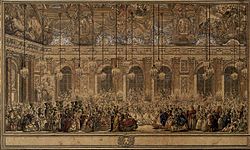
A masked ball in the Hall of Mirrors (1745) by Nicolas Cochin
Louis XIV died in 1715, and the young new King, Louis XV, just five years old, and his government were moved temporarily from Versailles to Paris under the regency of Philippe II, Duke of Orléans. In 1722, when the King came of age, he moved his residence and the government back to Versailles, where it remained until the French Revolution in 1789.[16] Louis XV remained faithful to the original plan of his great-grandfather, and made few changes to the exteriors of Versailles. His main contributions were the construction of the Salon of Hercules, which connected the main building of the Palace with the north wing and the chapel (1724–36); and the royal opera theater, designed by Ange-Jacques Gabriel, and built between 1769 and 1770. The new theater was completed in time for the celebration of the wedding of the Dauphin, the future Louis XVI, and Archduchess Marie Antoinette of Austria. He also made numerous additions and changes to the royal apartments, where he, the Queen, his daughters, and his heir lived. In 1738, Louis XV remodeled the king's petit appartement on the north side of the Cour de Marbre, originally the entrance court of the old château. He discreetly provided accommodations in another part of the palace for his famous mistresses, Madame de Pompadour and later Madame du Barry.
The extension of the King's petit appartement necessitated the demolition of the Ambassador's Staircase, one of the most admired features of Louis XIV's palace, which left the Palace without a grand staircase entrance.[18] The following year Louis XV ordered the demolition of the north wing facing onto the Cour Royale, which had fallen into serious disrepair.[19] He commissioned Gabriel to rebuild it in a more neoclassical style. The new wing was completed in 1780.
Louis XVI, and the Palace during the Revolution

Louis XVI and Marie Antoinette, with Lafayette, face the angry crowd from their balcony at Versailles, October 6, 1789
Louis XVI was constrained by the worsening financial situation of the kingdom from making major changes to the palace, so that he primarily focused on improvements to the royal apartments.[20] Louis XVI gave Marie Antoinette the Petit Trianon in 1774. The Queen made extensive changes to the interior, and added a theater, the Théâtre de la Reine. She also totally transformed the arboretum planted during the reign of Louis XV into what became known as the Hameau de la Reine. This was a picturesque collection of buildings modeled after a rural French hamlet, where the Queen and her courtiers could play at being peasants.[21] The Queen was at the Petit Trianon in 1789 when she first learned of the beginning of the French Revolution in July 1789.
In 1783, the Palace was the site of the signing of three treaties of the Peace of Paris (1783), in which the United Kingdom recognized the independence of the United States.
The King and Queen learned of the storming of the Bastille in Paris on July 14, 1789. while they were at the Palace, and remained isolated there as the Revolution in Paris spread. The growing anger in Paris led to the Women's March on Versailles on 5 October 1789. A crowd of several thousand men and women, protesting the high price and scarcity of bread, marched from the markets of Paris to Versailles. They took weapons from the city armory, besieged the Palace, and compelled the King and Royal family and the members of the National Assembly to return with them to Paris the following day.[22]
As soon as the royal family departed, the Palace was closed, awaiting their return. In 1792, the Convention, the new revolutionary government, ordered the transfer of all the paintings and sculptures from the Palace to the Louvre. In 1793, the Convention declared the abolition of the monarchy, and ordered all of the royal property in the Palace to be sold at auction. The auction took place between 25 August 1793 and 11 August 1794. The furnishings and art of the Palace, including the furniture, mirrors, baths and kitchen equipment, were sold in seventeen thousand lots. All fleurs-de-lys and royal emblems on the buildings were chambered or chiseled off. The empty buildings were turned into a storehouse for furnishings, art and libraries confiscated from the nobility. The empty grand apartments were opened for tours beginning in 1793, and a small museum of French paintings and art school was opened in some of the empty rooms.[23]
19th century - history museum and government venue

Banquet for Queen Victoria hosted by Napoleon III in the Royal Opera of Versailles, August 1855

Proclamation of the German Empire, 18 January 1871, 1877 by Anton von Werner
When Napoleon Bonaparte became Emperor of the French in 1804, he considered making Versailles his residence, but abandoned the idea because of the cost of the renovation. Prior to his marriage with Marie-Louise in 1810, he had the Grand Trianon restored and refurnished as a springtime residence for himself and his family, in the style of furnishing that it is seen today.[24]
In 1815, with the final downfall of Napoleon, Louis XVIII, the younger brother of Louis XVI, became King, and considered returning the royal residence to Versailles, where he had been born. He ordered the restoration of the royal apartments, but the task and cost was too great. Neither he nor his successor Charles X lived at Versailles.[24]
The French Revolution of 1830 brought a new monarch, Louis-Philippe to power, and a new ambition for Versailles. He did not reside at Versailles, but began the creation of the Museum of the History of France, dedicated to "all the glories of France", located in the south wing of the Palace, which had been used to house some members of the royal family. The museum was begun in 1833 and inaugurated on 30 June 1837. Its most famous room is the Galerie des Batailles (Hall of Battles), which lies on most of the length of the second floor.[20] Louis Philippe had the far end of the south wing of the Cour Royale demolished and rebuilt to match the Gabriel wing of 1780 opposite, which gave greater uniformity of appearance to the front entrance.[25] The museum project largely came to a halt when Louis Philippe was overthrown in 1848, though the paintings of French heroes and great battles still remain in the south wing.
Emperor Napoleon III used the Palace on occasion as a stage for grand ceremonies. One of the most lavish was the banquet that he hosted for Queen Victoria in the Royal Opera of Versailles on August 25, 1855.
During the Franco-Prussian War of 1870-1871, the Palace was occupied by the general staff of the victorious German Army. Parts of the chateau, including the Gallery of Mirrors, were turned into a military hospital. The creation of the German Empire, combining Prussia and the surrounding German states under William I, was formally proclaimed in the Hall of Mirrors on January 18, 1871. The Germans remained in the Palace until the signing of the armistice in March 1871. In that month, the government of the new Third French Republic, which had departed Paris during the War for Tours and then Bordeaux, moved into the Palace. The National Assembly held its meetings in the Opera House.[26]
The uprising of the Paris Commune in May, 1871, prevented the French government, under Adolphe Thiers, from returning immediately to Paris. The military operation which suppressed the Commune at the end of the month was directed from Versailles, and the prisoners of the Commune were marched there and put on trial in military courts. In 1875 a second parliamentary body, the French Senate, was created, and held its meetings for the election of a President of the Republic in a new hall created in 1876 in the south wing of the Palace. The French Senate continues to meet in the Palace on special occasions, such as the amendment of the French Constitution. [27]
20th century

The Signing of Peace in the Hall of Mirrors, Versailles, 28 June 1919 by William Orpen
The end of the 19th and the early 20th century saw the beginning of restoration efforts at the Palace, first led by Pierre de Nolhac, poet and scholar and the first conservator, who began his work in 1892. The conservation and restoration was interrupted by two world wars, but has continued until the present day.[28]
The Palace briefly returned to the world stage in June, 1919, when the Treaty of Versailles, formally ending the First World War, was signed in the Hall of Mirrors. Between 1925 and 1928, the American philanthropist and multi-millionaire John D. Rockefeller gave $2,166,000, the equivalent of about thirty million dollars today, to restore and refurnish the palace.[29]
More work took place after World War II, with the restoration of the Royal Opera of Versailles. The theater was reopened in 1957, in the presence of Queen Elizabeth II of Britain.
In 1978, parts of the Palace were heavily damaged in a bombing committed by Breton terrorists.
The restoration initiatives launched by the Fifth Republic have proven to be perhaps more costly than the expenditures of the palace in the Ancien Régime. Starting in the 1950s, when the museum of Versailles was under the directorship of Gérald van der Kemp, the objective was to restore the palace to its state – or as close to it as possible – in 1789 when the royal family left the palace. Among the early projects was the repair of the roof over the Hall of Mirrors; the publicity campaign brought international attention to the plight of post-war Versailles and garnered much foreign money including a grant from the Rockefeller Foundation. Concurrently, in the Soviet Union (Russia since 26 December 1991), the restoration of the Pavlovsk Palace located 25 kilometers from the center of Leningrad – today's Saint Petersburg – brought the attention of French Ministry of Culture, including that of the curator of Versailles.[30] After the war when Soviet authorities were restoring the palace, which had been gutted by the retreating Nazi forces, they recreated the silk fabrics by using preserved 18th-century remnants.[30]
When these results and the high quality achieved were brought to the attention of the French Minister of Culture, he revived 18th-century weaving techniques so as to reproduce the silks used in the decoration of Versailles.[30] The two greatest achievements of this initiative are seen today in wall hangings used in the restoration of the chambre de la reine in the grand appartement de reine and the chambre du roi in the appartement du roi. While the design used for the chambre du roi was, in fact, from the original design to decorate the chambre de la reine, it nevertheless represents a great achievement in the ongoing restoration at Versailles. Additionally, this project, which took over seven years to achieve, required several hundred kilograms of silver and gold to complete.[31] One of the more costly endeavours for the museum and France's Fifth Republic has been to repurchase as much of the original furnishings as possible. Consequently, because furniture with a royal provenance – and especially furniture that was made for Versailles – is a highly sought after commodity on the international market, the museum has spent considerable funds on retrieving much of the palace's original furnishings.[32]
21st century
In 2003, a new restoration initiative – the "Grand Versailles" project – was started, which began with the replanting of the gardens, which had lost over 10,000 trees during Hurricane Lothar on 26 December 1999. One part of the initiative, the restoration of the Hall of Mirrors, was completed in 2006.[33] Another major project was the further restoration of the backstage areas Royal Opera of Versailles, which was completed in 2009.
Ownership and management
The Palace of Versailles is owned by the French state. Its formal title is the Public Establishment of the Palace, Museum and National Estate of Versailles Since 1995, it has been run as a Public Establishment, with an independent administration and management supervised by the French Ministry of Culture. The current Chairperson of the Public Establishment is Catherine Pégard.[34]
Architecture and plan

The Marble Court and facades of the first Chateau, embellished by Louis Le Vau (1661–68) and then Hardouin-Mansart in (1679–1681)

Plan of the main floor (c. 1837, with north to the right), showing the Hall of Mirrors in red, the Hall of Battles in green, the Royal Chapel in yellow, and the Royal Opera in blue

Aerial view from the garden

The facade facing the garden, with the royal apartments and the Gallery of Mirrors between them
The Palace of Versailles offers a visual history of French architecture from the 17th century to the end of the 18th century. It began with the original château, with the brick and stone and sloping slate mansard roofs of the Louis XIII style used by architect Philibert Le Roy. It then became grander and more monumental, with the addition of the colonnades and flat roofs of the new royal apartments in the French classical or Louis XIV style, as designed by Louis Le Vau and later Jules Hardouin-Mansart. It concluded in the lighter and more graceful neoclassical Louis XVI style of the Petit Trianon, completed by Ange-Jacques Gabriel in 1768.
The palace was largely completed by the death of Louis XIV in 1715. The eastern facing palace has a U-shaped layout, with the corps de logis and symmetrical advancing secondary wings terminating with the Dufour Pavilion on the south and the Gabriel Pavilion to the north, creating an expansive cour d'honneur known as the Royal Court (Cour Royale). Flanking the Royal Court are two enormous asymmetrical wings that result in a facade of 402 metres (1,319 ft) in length.[35] Encompassing 67,000 square metres (721,182 sq ft) the palace has 700 rooms, more than 2,000 windows, 1,250 fireplaces and 67 staircases.[36]
The façade of Louis XIII's original château is preserved on the entrance front. Built of red brick and cut stone embellishments, the U-shaped layout surrounds a black-and-white marble courtyard. In the center, a 3-storey avant-corps fronted with eight red marble columns supporting a gilded wrought-iron balcony is surmounted with a triangle of lead statuary surrounding a large clock, whose hands were stopped upon the death of Louis XIV. The rest of the façade is completed with columns, painted and gilded wrought-iron balconies and dozens of stone tables decorated with consoles holding marble busts of Roman emperors. Atop the mansard slate roof are elaborate dormer windows and gilt lead roof dressings that were added by Hardouin-Mansart in 1679–1681.
Inspired by the architecture of baroque Italian villas, but executed in the French classical style, the garden front and wings were encased in white cut ashlar stone known as the enveloppe in 1668-1671 by Le Vau and modified by Hardouin-Mansart in 1678–1679.[37] The exterior features an arcaded, rusticated ground floor, supporting a main floor with round-headed windows divided by reliefs and pilasters or columns. The attic storey has square windows and pilasters and crowned by a balustrade bearing sculptured trophies and flame pots dissimulating a flat roof.
Royal Apartments

Plan of the main floor in the central part of the palace (c. 1742),[38] showing the grand appartement du roi in dark blue, the appartement du roi in medium blue, the petit appartement du roi in light blue, the grand appartement de la reine in yellow, and the petit appartement de la reine in red
The construction in 1668–1671 of Le Vau's enveloppe around the outside of Louis XIII's red brick and white stone château added state apartments for the king and the queen. The addition was known at the time as the château neuf (new château). The grands appartements (Grand Apartments, also referred to as the State Apartments[39]) include the grand appartement du roi and the grand appartement de la reine. They occupied the main or principal floor of the château neuf, with three rooms in each apartment facing the garden to the west and four facing the garden parterres to the north and south, respectively. The private apartments of the king (the appartement du roi and the petit appartement du roi) and those of the queen (the petit appartement de la reine) remained in the château vieux (old château). Le Vau's design for the state apartments closely followed Italian models of the day, including the placement of the apartments on the main floor (the piano nobile, the next floor up from the ground level), a convention the architect borrowed from Italian palace design.[40]
The king's State Apartment consisted of an enfilade of seven rooms, each dedicated to one of the known planets and their associated titular Roman deity. The queen's apartment formed a parallel enfilade with that of the grand appartement du roi. After the addition of the Hall of Mirrors (1678–1684) the king's apartment was reduced to five rooms (until the reign of Louis XV, when two more rooms were added) and the queen's to four.
The queen's apartments served as the residence of three queens of France - Marie-Thérèse d'Autriche, wife of Louis XIV, Marie Leczinska, wife of Louis XV, and Marie-Antoinette, wife of Louis XVI. Additionally, Louis XIV's granddaughter-in-law, Princess Marie-Adélaïde of Savoy, duchesse de Bourgogne, wife of the Petit Dauphin, occupied these rooms from 1697 (the year of her marriage) to her death in 1712.[b]
The State Apartments of the King

Meal at the House of Simon the Pharisee by Veronese in the Salon of Hercules
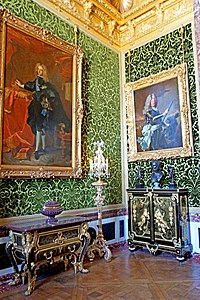
The Salon of Abundance

The Salon of Venus

The Salon of Mercury
The construction of the Hall of Mirrors between 1678 and 1686 coincided with a major alteration to the State Apartments. They were originally intended as his residence, but the King transformed them into galleries for his finest paintings, and venues for his many receptions for courtiers. During the season from All-Saints Day in November until Easter, these were usually held three times a week, from six to ten in the evening, with various entertainments.[41]
The Salon of Hercules
This was originally a chapel. It was rebuilt beginning in 1712 as a showcase for the painting Meal at the House of Simon the Pharisee by Paolo Veronese, which was a gift to Louis XIV from the Republic of Venice in 1664. The painting on the ceiling, The Apotheosis of Hercules, by François Lemoyne, was completed in 1712, and gave the room its name. [41]
The Salon of Abundance
The Salon of Abundance was the antechamber to the Cabinet of Curios (now the Games Room), which displayed Louis XIV's collection of precious jewels and rare objects. Some of the objects in the collection are depicted in René-Antoine Houasse's painting Abundance and Liberality (1683), located on the ceiling over the door opposite the windows.
The Salon of Venus
This salon was used for serving light meals during evening receptions. The principal feature in this room is Jean Warin's life-size statue of Louis XIV in the costume of a Roman emperor. On the ceiling in a gilded oval frame is another painting by Houasse, Venus subjugating the Gods and Powers (1672-1681). Trompe l'oeil paintings and sculpture around the ceiling illustrate mythological themes.[42]
The Salon of Mercury
The Salon of Mercury was the original State Bedchamber when Louis XIV officially moved the court and government to the Palace in 1682. The bed is a replica of the original commissioned by King Louis-Philippe in the 19th century when he turned the Palace into a Museum. The ceiling paintings by the Flemish artist Jean Baptiste de Champaigne depicts the god Mercury in his chariot, drawn by a rooster, and Alexander the Great and Ptolemy surrounded by scholars and philosophers. The Automaton Clock was made for the King by the royal clockmaker Antoine Morand in 1706. When it chimes the hour, figures of Louis XIV and Fame descend from a cloud.[43]

Salon of Mars

Ceiling in the Salon of Apollo, depicting the Sun Chariot of Apollo
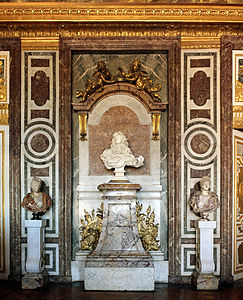
Bust of Louis XIV by Bernini in Salon of Diana
The Salon of Mars
The Salon of Mars was used by the royal guards until 1782, and was decorated on a military theme with helmets and trophies. It was turned into a concert room between 1684 and 1750, with galleries for musicians on either side. Portraits of Louis XV and his Queen, Marie Leszczinska, by the Flemish artist Carle Van Loo decorate the room today.
The Salon of Apollo
The Salon of Apollo was the royal throne room under Louis XIV, and was the setting for formal audiences. The eight-foot high silver throne was melted down in 1689 to help pay the costs of an expensive war, and was replaced by a more modest throne of gilded wood. The central painting on the ceiling, by Charles de la Fosse, depicts the Sun Chariot of Apollo, the King's favorite emblem, pulled by four horses and surrounded by the four seasons.
The Salon of Diana
The Salon of Diana was used by Louis XIV as a billiards room, and had galleries from which courtiers could watch him play. The decoration of the walls and ceiling depicts scenes from the life of the goddess Diana. The celebrated bust of Louis XIV by Bernini made during the famous sculptor's visit to France in 1665, is on display here. [44]
Private apartments of the King and Queen
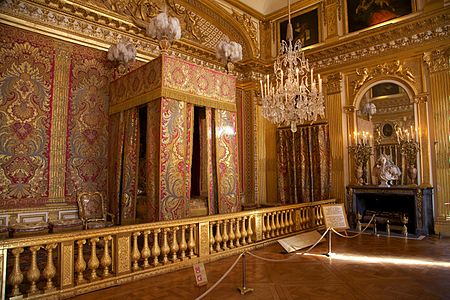
The King's bedchamber

The Queen's bedchamber
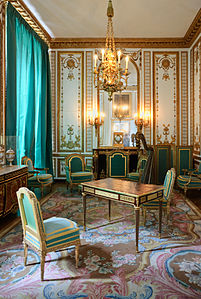
The gilded cabinet of Marie-Antoinette

Billiard Room of Marie-Antoinette
Private apartments of the King
The apartments of the King were the heart of the chateau; they were in the same location as the rooms of Louis XIII, the creator of the chateau, on the first floor (second floor US style). They were set aside for the personal use of Louis XIV in 1683. He and his successors Louis XV and Louis XVI used these rooms for official functions, such as the ceremonial lever ("waking up") and the coucher ("going to bed") of the monarch, which were attended by a crowd of courtiers.
The King's apartment was accessed from the Hall of Mirrors from the Oeil de Boeuf antechamber past the Guardroom and the Grand Couvert, the ceremonial room where Louis XIV often took his evening meals, seated alone at a table in front of the fireplace. His spoon, fork, and knife were brought to him in a golden box. The courtiers could watch as he dined.[45]
The King's bedchamber had originally been the State Drawing Room and had been used by Queen Marie-Theresa, but after her death in 1701 Louis XIV took it over to use as his own bedroom and died there on September 1, 1715. Both Louis XV and Louis XVI continued to use the bedroom for their official awakening and going to bed. On October 6, 1789, from the balcony of this room Louis XVI and Marie-Antoinette, joined by the Marquis de Lafayette, looked down on the hostile crowd in the courtyard, shortly before the King was forced to return to Paris.[45]
The bed of the King is placed beneath a carved relief by Nicolas Coustou entitled France watching over the sleeping King. The decoration includes several paintings set into the paneling, including a self-portrait of Antony Van Dyck.[45]
Private apartments of The Queen
The petit appartement de la reine is a suite of rooms that were reserved for the personal use of the queen. Originally arranged for the use of the Marie-Thérèse, consort of Louis XIV, the rooms were later modified for use by Marie Leszczyńska and finally for Marie-Antoinette. The Queen's apartments and the King's Apartments were laid out on the same design, each suite having seven rooms. Both suites had ceilings painted with scenes from mythology; the King's ceilings featured male figures, the Queen's featured females.
The Grand Gallery

The Peace Salon
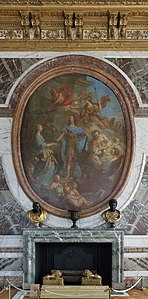
The Peace Salon; Louis XV sharing benefits of peace by François Lemoyne
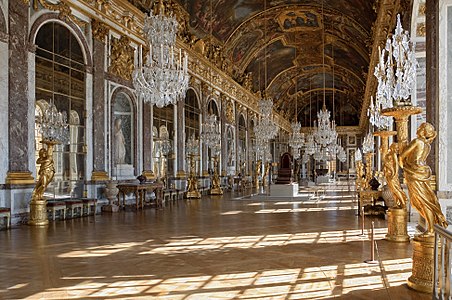
The Galerie des Glaces or Hall of Mirrors
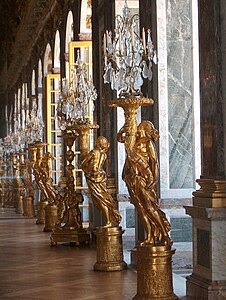
Guerdirons or candle holders in the Hall of Mirrors

Relief of Louis XIV in the Salon of War, by Antoine Coysevox (1715)
The Grand Gallery is a set of three highly decorated reception rooms, dedicated to the celebration of the political and military successes of Louis XIV, and used for important ceremonies, celebrations and receptions.
The War Salon
The War Salon commemorates the victorious campaign of Louis XIV against the Dutch, which ended in 1678. The centerpiece is an enormous sculpted medallion of Louis XIV, on horseback, crossing the Rhine in 1672, created by Antoine Coysevox. Above the fireplace is a painting of Clio, the Muse of History, recording the exploits of the King.
The Hall of Mirrors
The Galerie des Glaces (Hall of Mirrors), is perhaps the most famous room in the château of Versailles. It took the place of the rooftop terrace overlooking the gardens which formerly connected the apartments of the King and Queen. The construction of the room began in 1678 and finished in 1689. The gallery is more than 70 metres (230 ft) long, and it is lined with 17 wide arcaded mirrors, designed to match and reflect the windows opposite facing the gardens. Charles Le Brun painted thirty scenes of the early reign of Louis XIV on the ceiling. The centerpiece is a painting of the King titled, "The King Governing Alone". It shows Louis XIV, facing the powers of Europe, turning away from his pleasures to accept a crown of immortality from Glory, with the encouragement of Mars.[46]
The hall was originally furnished with solid silver furniture designed by Le Brun, but these furnishings were melted down in 1689 to help pay for war expenses. The King kept a silver throne, usually located in the Salon of Apollo, which was brought to the Hall of Mirrors for formal ceremonies, such as the welcome of foreign ambassadors, including a delegation from the King of Siam in 1686. It was also used for large events, such as full-dress and masked balls. Light was provided by candelabra on large gilded guerdirons lining the hall. Those on display today were made in 1770 for the marriage of Louis XVI and Marie Antoinette, based on the moldings of earlier silver versions made by LeBrun that had been melted down. The twenty-four crystal chandeliers were hung only for special occasions. Courtiers gathered in the Hall to watch the King walk from his apartments to the chapel, and sometimes took the occasion to present him with requests.
[46]
The Peace Salon
The Peace Salon is decorated to illustrate the role of France as the arbiter and peacemaker of Europe under Louis XV. The painting on the ceiling by François Lemoyne, Louis XV offering an olive branch to Europe, illustrates this theme. During the reign of Louis XV, the Queen, Marie Leszczyńska, used this salon as a music room, organizing concerts of secular and religious music each Sunday.[47]
Royal Chapel
Royal Chapel seen from the ground floor
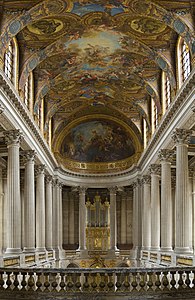
The Royal Chapel, seen from the Royal Gallery
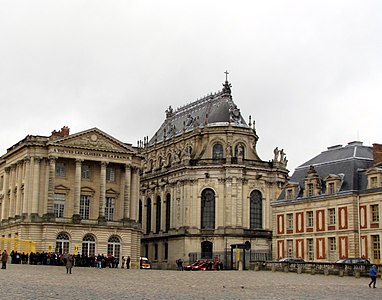
The Royal Chapel, the tallest building of the Palace
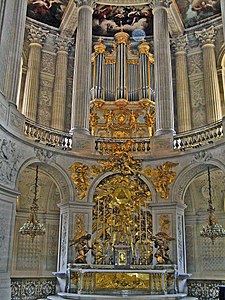
Altar and organ of the Royal Chapel

Glory holding a portrait of Louis XV, by Antoine Vassé, in the chapel vestibule
The Chapel was the last building at Versailles to be completed during the reign of Louis XIV. It was consecrated in 1710, and was dedicated to Louis IX of France, the ancestor and patron saint of the King. Construction was begun by Hardouin-Mansart in 1699, and was completed by de Corte. Daily services, wedding ceremonies, and baptisms were held in this chapel until 1789. Like other royal chapels, it had two levels: the King and family worshipped in the Royal Gallery on the upper level, while ordinary courtiers stood on the ground level.[48]
The paintings on the ceiling display scenes depicting the three figures of the trinity. In the center is The Glory of the Father Announcing the Coming of the Messiah by Antoine Coypel, above the altar is The Resurrection of Christ, and above the royal gallery is The Holy Spirit Descending Upon the Virgin and the Apostles. The corridor and vestibule that connected the Chapel and the State Apartments included later art, commissioned by Louis XV, intended to portray the link between Divinity and the King: a statue of Glory Holding the Medallion of Louis XV, by Antoine Vassé; and Royal Magnanimity by Jacques Bousseau.[49]
Royal Opera
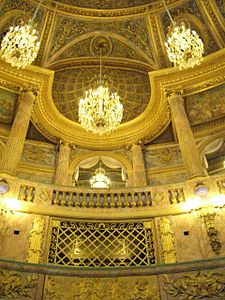
The Royal Box
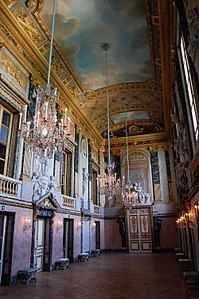
Foyer of the Royal Opera
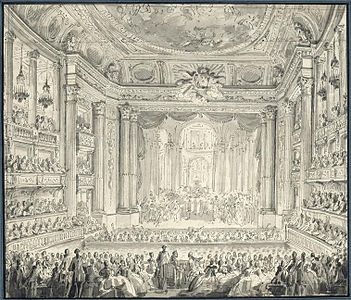
The Royal Opera during the celebration of the marriage of Louis XVI and Marie-Antoinette (1770)

Stage of the Royal Opera

Ceiling of the opera, painted by Louis Jean-Jacques Durameau
The Royal Opera of Versailles was originally commissioned by Louis XIV in 1682 and was to be built at the end of the North Wing with a design by Mansart and Vigarani. However, due to the expense of the King's continental wars, the project was put aside. The idea was revived by Louis XV with a new design by Ange-Jacques Gabriel in 1748, but this also was temporarily put aside. The project was revived and rushed ahead for the planned celebration of the marriage of the Dauphin, the future Louis XVI, and Marie-Antoinette. For economy and speed, the new opera was built almost entirely of wood, which also gave it very high quality acoustics. The wood was painted to resemble marble, and the ceiling was decorated with a painting of the Apollo, the god of the arts, preparing crowns for illustrious artists, by Louis Jean-Jacques Durameau. The sculptor Augustin Pajou added statuary and reliefs to complete the decoration. The new Opera was inaugurated on May 16, 1770, as part of the celebration of the royal wedding.[50]
In October 1789, early in the French Revolution, the last banquet for the royal guardsmen was hosted by the King in the opera, before he departed for Paris. Following the Franco-German War in 1871 and then the Paris Commune until 1875, the French National Assembly met in the opera, until the proclamation of the Third French Republic and the return of the government to Paris.[9]
Museum of the History of France

Louis Philippe dedicates the Gallery of Battles, by François Joseph Heim (1837)
The Gallery of Battles in the Museum of the History of France

The Battle of Taillebourg, by Eugène Delacroix (1837)

Louis Philippe and his sons pose before the gates of Versailles, by Horace Vernet History Gallery, (1846)
Shortly after becoming King in 1830, Louis Philippe I decided to transform the Palace, which was empty of furnishings and in poor repair, into a museum devoted to "All the Glories of France," with paintings and sculpture depicting famous French victories and heroes. The walls of the apartments of the courtiers and lesser members of the royal family on the first floor (second floor U.S. style) were demolished, and turned into a series of several large galleries: the Coronation Room, which displays the celebrated painting of the coronation of Napoleon I by Jacques-Louis David; the Hall of Battles; commemorating French victories with large-scale paintings; and the 1830 room, which celebrated Louis-Philippe's own coming tol power in the French Revolution of 1830. Some paintings were brought from the Louvre, including works depicting events in French history by Philippe de Champaigne, Pierre Mignard, Laurent de La Hyre, Charles Le Brun, Adam Frans van der Meulen, Nicolas de Largillière, Hyacinthe Rigaud, Jean-Antoine Houdon, Jean-Marc Nattier, Élisabeth Vigée Le Brun, Hubert Robert, Thomas Lawrence, Jacques-Louis David, and Antoine-Jean Gros. Others were commissioned especially for the museum by prominent artists of the early 19th century, including Eugène Delacroix, who painted Saint Louis at the French victory over the British in the Battle of Taillebourg in 1242. Other painters featured include Horace Vernet and François Gérard. A monumental painting by Vernet features Louis Philippe himself, with his sons, posing in front of the gates of the Palace.[51]
The overthrow of Louis Philippe in 1848 put an end to his grand plans for the museum, but the Gallery of Battles is still as it was, and is passed through by many visitors to the royal apartments and grand salons. Another set of rooms on the first floor has been made into galleries on Louis XIV and his court, displaying furniture, paintings, and sculpture. In recent years, eleven rooms on the ground floor between the Chapel and the Opera have been turned into a history of the palace, with audiovisual displays and models.[52]
Gardens and fountains

Bassin de Flore (1672-1679)

The Orangerie garden

Fountain of Latona, with the Grand Canal in the background
André Le Nôtre began transforming the park and gardens of Versailles in the early 1660s.[53] They are the finest example of the jardin à la française, or the French formal garden. They were originally designed to be viewed from the terrace on the west side of the palace, and to create a grand perspective that reached to the horizon, illustrating the king's complete dominance over nature.
The Parterre d'Eau and the Parterre and Fountain of Latona
The features closest to the Palace are the two water parterres, large pools which reflect the facade of the palace. These are decorated with smaller works of sculpture, representing the rivers of France, which are placed so as not to interfere with the reflections in the water. Down a stairway from the Parterre d'Eau is the Latona Fountain, created in 1670, illustrating the story of Latona taken from the Metamorphoses of Ovid. According to the story, when the peasants of Lycia insulted Latona, the mother of Apollo and Diana, the god Jupiter transformed the peasants into frogs. The fountain was begun in 1670 by Le Nôtre, then enlarged and modified by Hardouin-Mansart, who placed the statue of Latona atop a marble pyramid.[54]
Fountain of the Chariot of Apollo and the Grand Canal
The Grand Perspective of the palace continues from the Fountain of Latona south along a grassy lane, the Tapis Vert or green carpet, to the Basin of the Chariot of Apollo. Apollo, the sun god, was the emblem of Louis XIV, featured in much of the decoration of the palace. The chariot rising from the water symbolized the rising of the sun. It was designed by Le Brun and made by the sculptor Jean-Baptiste Tuby between 1668 and 1670, cast in iron and then gilded. Beyond the fountain, the Grand Canal extends 1800 meters to the south end of the park.[54]
North Parterre, Dragon Basin, and Basin of Neptune
Another group of formal gardens is located on the north side of the water parterre. It includes two bosquets or groves: the grove of the Three Fountains, The Bosquet of the Arch of Triumph, and north of these, three major fountains, the Pyramid Fountain, Dragon Fountain, and the Neptune Fountain. The fountains in this area all have a maritime or aquatic theme; the Pyramid Fountain is decorated with Tritons, Sirens, dolphins and nymphs. The Dragon Fountain is one of the oldest at Versailles and has the highest jet of water, twenty-seven meters. It is not actually a dragon, but a python, a mythical serpent that was killed by Apollo. The Neptune Fountain was originally decorated only with a circle of large lead basins jetting water; Louis XV added statues of Neptune, Triton and other gods of the sea.[55]
South Parterre and the Orangerie
The South Parterre is located beneath the windows of the queen's apartments and on the roof of the Orangerie. It is decorated with box trees and flowers in arabesque patterns. The underground orangerie was designed to hold over a thousand citrus fruit, palms and oleanders, and other southern-climate trees during winter. They are taken out into the gardens from mid-May until mid-October.[55]
The Fountains and the Shortage of Water
Supplying water for the fountains of Versailles was a major problem for the royal government. The 18th-century waterworks at Marly— the Machine de Marly that fed the fountains— was possibly the biggest mechanical system of its time. The water came in from afar on monumental stone aqueducts which have long ago fallen into disrepair or been torn down. Some aqueducts, such as the unfinished Canal de l'Eure, which passes through the gardens of the Château de Maintenon, were never completed for want of resources or due to the exigencies of war. Despite enormous investment in canals and machinery for hoisting water, Versailles never had a sufficient water supply for its hundreds of fountains. When the King promenaded in the gardens, fountains were turned on only when the King was approaching them, and turned off after he departed. Today, only a few fountains are supplied with water, and only operate on a very limited schedule.
The Bosquets or Groves
The Three Fountains Bosquet
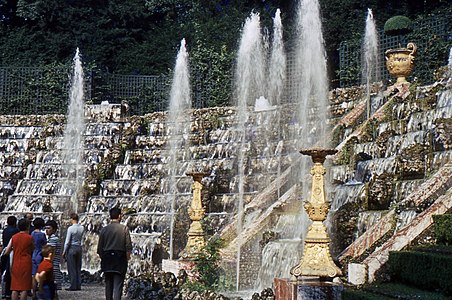
The Ballroom Bosquet

The Colonnade Bosquet
The largest part of the garden is divided into geometric bosquets, compartment-like groves; eight on the north side of the garden, and six to the south. The bosquets were created for Louis XIV between 1680 and 1690. They were bordered with high trees and carefully trimmed in cubic forms to resemble rooms with walls of greenery. Each bosquet had its own theme and fountains, statuary, grottoes, and other decoration. Some were highly formal, like Hardouin-Mansart's Bosquet de la Colonnade, with a circle of columns alternating with fountains, while others imitated nature. They were often used for concerts or theatrical performances. Some of the early groves were altered beyond recognition by later monarchs, but the most famous bosquets, Le Nôtre's Salle de Bal (literally, "ballroom"), also known as the Bosquet des Rocailles (c. 1685), and Hardouin-Mansart's Bosquet de la Colonnade, have both been restored to the way they were under Louis XIV. Other notable groves include Les Dômes, the Bosquet d'Encelade (after Enceladus, c. 1675), the Théâtre d'Eau (Water Theater), and the Bains d'Apollon (Baths of Apollo). Some are now decorated with contemporary works of art.[56]
The Grand Trianon and Petit Trianon
Peristyle of the Grand Trianon
West facade of the Petit Trianon

The Temple of Love
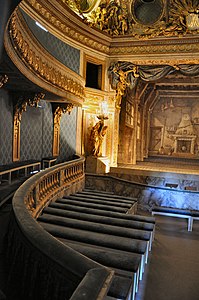
The Queen's Theater at the Petit Trianon
In 1668 Louis XIV decided to build a smaller palace some distance from the main palace, where he could spend quieter time away from the crowds and formality of his Court. He purchased a village called Trianon which adjoined the park, and constructed a pavilion covered with blue and white porcelain in the fashionable Chinese style; it was finished in 1670, and became known as the Porcelain Trianon. In 1687, he replaced it with the Grand Trianon, a larger and more classical pavilion designed by Mansart, with a terrace and walls faced with different colored slabs of marble. After the Revolution, the Trianon served as a residence for both Napoleon I and later for King Louis-Philippe when they visited Versailles. It is decorated today largely as it was under Napoleon and Louis-Philippe.[56]
The Petit Trianon was created between 1763 and 1768 by Ange-Jacques Gabriel for Louis XV. The square shaped building, with each facade different, was a prototype of Neoclassicism in France. The most ornate facade, with Corinthian columns, faced the French landscape garden. Louis XVI gave the Petit Trianon as a gift to his bride, Marie-Antoinette. She asked the architect Richard Mique and painter Hubert Robert to design a new English-style landscape garden to replace the formal French garden. Not far from the Petit Trianon she had the Rock Pavilion constructed, and added the classical rotunda of the Temple of Love, built in 1777. In 1780, she built a small theater at the Petit Trianon. In her theater she played a part in one of the first performances of the play The Marriage of Figaro by Pierre Beaumarchais, which helped ensure its success. She was at the Petit Trianon in July 1789 when she first heard the news from Paris of the storming of the Bastille and the beginning of the French Revolution.[56]
The Hamlet of Marie Antoinette

One of the most celebrated features of the park is the Hameau de la Reine, a small rustic hamlet near the Petit Trianon created for Queen Marie Antoinette between 1783 and 1785 by the royal architect Richard Mique with the help of the painter Hubert Robert. It replaced a botanical garden created by Louis XV, and consisted of twelve structures, ten of which still exist, in the style of villages in Normandy. It was designed for the Queen and her friends to amuse themselves by playing peasants, and included a farmhouse with a dairy, a mill, a boudoir, a pigeon loft, a tower in the form of a lighthouse from which one could fish in the pond, a belvedere, a cascade and grotto, and a luxuriously furnished cottage with a billiard room for the Queen.[57]
Modern Political and ceremonial functions
The palace still serves political functions. Heads of state are regaled in the Hall of Mirrors; the bicameral French Parliament—consisting of the Senate (Sénat) and the National Assembly (Assemblée nationale)—meet in joint session (a congress of the French Parliament) in Versailles[58] to revise or otherwise amend the French Constitution, a tradition that came into effect with the promulgation of the 1875 Constitution.[60] For example, the Parliament met in joint session at Versailles to pass constitutional amendments in June 1999 (for domestic applicability of International Criminal Court decisions and for gender equality in candidate lists), in January 2000 (ratifying the Treaty of Amsterdam), and in March 2003 (specifying the "decentralized organization" of the French Republic).[58]
In 2009, President Nicolas Sarkozy addressed the global financial crisis before a congress in Versailles, the first time that this had been done since 1848, when Charles-Louis Napoleon Bonaparte gave an address before the French Second Republic.[61][62][63] Following the November 2015 Paris attacks, President François Hollande gave a speech before a rare joint session of parliament at the Palace of Versailles.[64] This was the third time since 1848 that a French president addressed a joint session of the French Parliament at Versailles.[65] The president of the National Assembly has an official apartment at the Palace of Versailles.[66]
Cost
One of the most baffling aspects to the study of Versailles is the cost – how much Louis XIV and his successors spent on Versailles. Owing to the nature of the construction of Versailles and the evolution of the role of the palace, construction costs were essentially a private matter. Initially, Versailles was planned to be an occasional residence for Louis XIV and was referred to as the "king's house".[67] Accordingly, much of the early funding for construction came from the king's own purse, funded by revenues received from his appanage as well as revenues from the province of New France (Canada), which, while part of France, was a private possession of the king and therefore exempt from the control of the Parliaments.[68]
Once Louis XIV embarked on his building campaigns, expenses for Versailles became more of a matter for public record, especially after Jean-Baptiste Colbert assumed the post of finance minister. Expenditures on Versailles have been recorded in the compendium known as the Comptes des bâtiments du roi sous le règne de Louis XIV and which were edited and published in five volumes by Jules Guiffrey in the 19th century. These volumes provide valuable archival material pursuant to the financial expenditure on all aspects of Versailles such as the payments disbursed for many trades as varied as artists and mole catchers.[69]
To counter the costs of Versailles during the early years of Louis XIV's personal reign, Colbert decided that Versailles should be the "showcase" of France.[70] Accordingly, all materials that went into the construction and decoration of Versailles were manufactured in France. Even the mirrors used in the decoration of the Hall of Mirrors were made in France. While Venice in the 17th century had the monopoly on the manufacture of mirrors, Colbert succeeded in enticing a number of artisans from Venice to make the mirrors for Versailles. However, owing to Venetian proprietary claims on the technology of mirror manufacture, the Venetian government ordered the assassination of the artisans to keep the secrets proprietary to the Venetian Republic.[70] To meet the demands for decorating and furnishing Versailles, Colbert nationalised the tapestry factory owned by the Gobelin family, to become the Manufacture royale des Gobelins.[70]
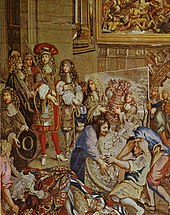
Louis XIV visits the Gobelins with Colbert, 15 October 1667. Tapestry from the series, "Histoire du roi" designed by Charles Le Brun and woven between 1667 and 1672. Articles of Louis XIV's silver furniture are seen in this tapestry.
In 1667, the name of the enterprise was changed to the Manufacture royale des Meubles de la Couronne. The Gobelins were charged with all decoration needs of the palace, which was under the direction of Charles Le Brun.[70]
One of the most costly elements in the furnishing of the grands appartements during the early years of the personal reign of Louis XIV was the silver furniture, which can be taken as a standard – with other criteria – for determining a plausible cost for Versailles. The Comptes meticulously list the expenditures on the silver furniture – disbursements to artists, final payments, delivery – as well as descriptions and weight of items purchased. Entries for 1681 and 1682 concerning the silver balustrade used in the salon de Mercure serve as an example:
- Year 1681
II. 5 In anticipation: For the silver balustrade for the king's bedroom: 90,000 livres
II. 7 18 November to Sieur du Metz, 43,475 livres 5 sols for delivery to Sr. Lois and to Sr. de Villers for payment of 142,196 livres for the silver balustrade that they are making for the king's bedroom and 404 livres for tax: 48,861 livres 5 sol.
II. 15 16 June 1681 – 23 January 1682 to Sr. Lois and Sr. de Villers silversmiths on account for the silver balustrade that they are making for the king's use (four payments): 88,457 livres 5 sols.
II. 111 25 March – 18 April to Sr. Lois and Sr. de Villers silversmiths who are working on a silver balustrade for the king, for continued work (two payments): 40,000 livres
- Year 1682
II. 129 21 March to Sr. Jehannot de Bartillay 4,970 livres 12 sols for the delivery to Sr. Lois and de Villers silversmiths for, with 136,457 livres 5 sol to one and 25,739 livres 10 sols to another, making the 38 balusters, 17 pilasters, the base and the cornice for the balustrade for the château of Versailles weighing 4,076 marc at the rate of 41 livres the marc[c] including 41 livres 2 sols for tax: 4,970 livres 12 sols.[69]
Accordingly, the silver balustrade, which contained in excess of one ton of silver, cost in excess of 560,000 livres. It is difficult – if not impossible – to give an accurate rate of exchange between 1682 and today.[d] However, Frances Buckland provides valuable information that provides an idea of the true cost of the expenditures at Versailles during the time of Louis XIV. In 1679, Mme de Maintenon stated that the cost of providing light and food for twelve people for one day amounted to slightly more than 14 livres.[71] In December 1689, to defray the cost of the War of the League of Augsburg, Louis XIV ordered all the silver furniture and articles of silver at Versailles – including chamber pots – sent to the mint to be melted.[72]
Clearly, the silver furniture alone represented a significant outlay in the finances of Versailles. While the decoration of the palace was costly, certain other costs were minimised. For example, labour for construction was often low, due largely to the fact that the army during times of peace and during the winter, when wars were not waged, was pressed into action at Versailles. Additionally, given the quality and uniqueness of the items produced at the Gobelins for use and display at Versailles, the palace served as a venue to showcase not only the success of Colbert's mercantilism, but also to display the finest that France could produce.[73]
Estimates of the amount spent to build Versailles are speculative. An estimate in 2000 placed the amount spent during the Ancien Régime as US$2 billion,[74] this figure being, in all probability, an under-evaluation. France's Fifth Republic expenditures alone, directed to restoration and maintenance at Versailles, may have surpassed those of the Sun King.
In popular culture
- Films
Madagascar 3: Europe's Most Wanted (2012) is an animated film in which sophisticated chimpanzees Mason and Phil dress up as "King of Versailles" in reference to the Palace of Versailles
Marie Antoinette (2006) is a film written and directed by Sofia Coppola and starring Kirsten Dunst. It is based on the life of Queen Marie Antoinette in the years leading up to the French Revolution, filmed on location at the Palace of Versailles.
- Music
- "The Palace of Versailles" is a song by singer-songwriter Al Stewart, detailing the French Revolution, The Terror, and Napoléon Bonaparte's military coup, from the perspective of "the lonely Palace of Versailles"
- On 2 July 2005, the French Live 8 was held in the courtyard of Versailles
- Television
- In the Doctor Who episode, "Girl in the Fire Place" (2005), The Doctor met the Madame de Pompadour in the Palace of Versailles
Let Them Eat Cake, a 1999 BBC comedy starring Jennifer Saunders and Dawn French, is set within the Palace.
Versailles is a 2015 British-American-Franco-Canadian television series set during the construction of Versailles Palace during the reign of Louis XIV
- Video games
Assassin's Creed Rogue is set in Versailles at the end of the game
Assassin's Creed Unity is set in Versailles at the beginning of the game
Castlevania: Bloodlines is a Konami video game in which Versailles is the fifth stage
Gallery

Panoramic view from the park

Panoramic view from the city
See also
- Bureau du Roi
- List of Baroque residences
- Paris Peace Conference, 1919
- Peterhof Palace
- Style Louis XIV
Tennis Court Oath (French: serment du jeu de paume) in the Saint-Louis district- Treaty of Versailles
- Versailles Cathedral
Notes
^ Under Louis XIV the garden and park were enlarged further, eventually reaching 2,473 ha; they are now only 815 ha (Hoog 1996, p. 372).
^ Six kings were born in this room: Philip V of Spain, Louis XV, Louis XVI, Louis XVII, Louis XVIII, and Charles X.
^ The marc, a unit equal to 8 ounces, was used to weigh silver and gold.
^ As of 4 April 2008, silver has been trading in New York at US$17.83 an ounce.
References
Footnotes
^ Wells, John C. (2008). Longman Pronunciation Dictionary (3rd ed.). Longman. ISBN 978-1-4058-8118-0..mw-parser-output cite.citation{font-style:inherit}.mw-parser-output q{quotes:"""""""'""'"}.mw-parser-output code.cs1-code{color:inherit;background:inherit;border:inherit;padding:inherit}.mw-parser-output .cs1-lock-free a{background:url("//upload.wikimedia.org/wikipedia/commons/thumb/6/65/Lock-green.svg/9px-Lock-green.svg.png")no-repeat;background-position:right .1em center}.mw-parser-output .cs1-lock-limited a,.mw-parser-output .cs1-lock-registration a{background:url("//upload.wikimedia.org/wikipedia/commons/thumb/d/d6/Lock-gray-alt-2.svg/9px-Lock-gray-alt-2.svg.png")no-repeat;background-position:right .1em center}.mw-parser-output .cs1-lock-subscription a{background:url("//upload.wikimedia.org/wikipedia/commons/thumb/a/aa/Lock-red-alt-2.svg/9px-Lock-red-alt-2.svg.png")no-repeat;background-position:right .1em center}.mw-parser-output .cs1-subscription,.mw-parser-output .cs1-registration{color:#555}.mw-parser-output .cs1-subscription span,.mw-parser-output .cs1-registration span{border-bottom:1px dotted;cursor:help}.mw-parser-output .cs1-hidden-error{display:none;font-size:100%}.mw-parser-output .cs1-visible-error{font-size:100%}.mw-parser-output .cs1-subscription,.mw-parser-output .cs1-registration,.mw-parser-output .cs1-format{font-size:95%}.mw-parser-output .cs1-kern-left,.mw-parser-output .cs1-kern-wl-left{padding-left:0.2em}.mw-parser-output .cs1-kern-right,.mw-parser-output .cs1-kern-wl-right{padding-right:0.2em}
^ point zero at square in front of Notre Dame
^ Annual Report of the Regional Committee on Tourism of the Ile-de-France Region, cited in La Croix, 22 February 2018.
^ ab Hoog 1996, p. 369.
^ Lacaille 2012, p. 3.
^ abc Lacaille 2012, pp. 4-5.
^ Garriques 2001, p. 274.
^ Constans 1998, p. 24.
^ ab "Palace of Versailles | palace, Versailles, France". Encyclopedia Britannica. Retrieved 28 August 2017.
^ Hoog 1996, p. 370.
^ Ayers 2004, pp. 334–336.
^ Lacaille 2012, p. 3-6.
^ ab Lacaille 2012, p. 3=6.
^ Berger 1985a, pp. 17–19.
^ Lacaille 2012, p. 8.
^ ab Lacaille 2012, pp. 15-20.
^ Ayers 2004, pp. 336–339; Maral 2010, pp. 215–229.
^ Tony Spawforth. Versailles. p. 9.
^ Tony Spawforth. Versailles. p. 22.
^ ab Hoog 1996.
^ Hoog 1996, pp. 373–374.
^ Lacaille, 2012 & pages 16-17.
^ Lacaille, 2012 & pages 18.
^ ab Lacaille 2012, p. 19.
^ Tony Spawforth. Versailles. p. 244.
^ Lacaille 2012, p. 12.
^ Lacaille 2012, p. 20.
^ Lacaille, 2013 & page 13.
^ Iverson, Jeffrey, France Today, July 19, 2014
^ abc Massie 1990[page needed]
^ Meyer 1989[page needed]
^ Kemp 1976[page needed]
^ Leloup 2006[page needed]
^ Site of the Public Establishment of the Chateau of Versailles (en.chateauversailles.fr)
^ "History of Art". Visual Arts Cork. Retrieved 10 August 2016.
^ "Palace of Versailles". Dimensions Info. Retrieved 10 August 2016.
^ Ayers 2004, pp. 334–335, 337.
^ Blondel 1752–1756, vol. 4 (1756), book 7, plate 8; Nolhac 1898, p. 49 (dates Blondel's plan to c. 1742).
^ Saule & Meyrer 2000, pp. 18, 22; Michelin Tyre 1989, p. 182.
^ Berger 1985b24–25; Ayers 2004
^ ab Saule 2013, p. 20.
^ Saule 2013, p. 22.
^ Saule 2013, p. 25.
^ Saule 2013, p. 23.
^ abc Saule 2016, p. 32.
^ ab Saule 2013, p. 30.
^ Saule 2013, p. 31.
^ "Encyclopedia Britannica"
^ Saule 2013, p. 16.
^ Saule 2013, p. 60.
^ Saule 2013, pp. 18-19.
^ Saule 2013, pp. 18–19.
^ Berger 1985b, p. 5.
^ ab Saule 2013, p. 68.
^ ab Saule 2013, p. 73.
^ abc Saule 2013, p. 78-85.
^ Saule 2014, p. 92.
^ ab William Safran, "France" in Politics in Europe (M. Donald Hancock et al., CQ Sage: 5th ed. 2012).
^ "Constitution of 1875".
^ Article 9: Le siège du pouvoir exécutif et des deux chambres est à Versailles.[59]
^ Associated Press, Breaking tradition, Sarkozy speaks to parliament (22 June 2009).
^ Jerry M. Rosenberg, "France" in The Concise Encyclopedia of The Great Recession 2007-2012 (Scarecrow Press: 2012), p. 262.
^ Associated Press, The Latest: US Basketball Player James Not Going to France (16 November 2015).
^ Associated Press, The Latest: Brother Linked to Paris Attacks in Disbelief (16 November 2015).
^ Francois Hollande: 'France is at war', CNN (16 November 2015).
^ Georges Bergougnous, Presiding Officers of National Parliamentary Assemblies: A World Comparative Study (Inter-Parliamentary Union: Geneva, 1997), p. 39.
^ La Varende 1959[page needed]
^ Bluche 1986[page needed]; Bluche 1991[page needed]; Chouquette 1997[page needed]
^ ab Guiffrey 1880–1890[page needed]
^ abcd Bluche 1991[page needed]
^ Buckland 1983[page needed]
^ Dangeau 1854–1860[page needed]
^ Bluche 1986[page needed]; Bluche 1991[page needed]
^ Littell 2000[page needed]
Works cited
.mw-parser-output .refbegin{font-size:90%;margin-bottom:0.5em}.mw-parser-output .refbegin-hanging-indents>ul{list-style-type:none;margin-left:0}.mw-parser-output .refbegin-hanging-indents>ul>li,.mw-parser-output .refbegin-hanging-indents>dl>dd{margin-left:0;padding-left:3.2em;text-indent:-3.2em;list-style:none}.mw-parser-output .refbegin-100{font-size:100%}
Ayers, Andrew (2004). The Architecture of Paris. Stuttgart, London: Edition Axel Menges. ISBN 9783930698967.
Berger, Robert W. (1985a). In the Garden of the Sun King: Studies on the Park of Versailles Under Louis XIV. Washington, DC: Dumbarton Oaks Research Library.
Berger, Robert W. (1985b). Versailles: The Château of Louis XIV. University Park: The College Arts Association.
Blondel, Jacque-François (1752–1756). Architecture françoise, ou Recueil des plans, élévations, coupes et profils des églises, maisons royales, palais, hôtels & édifices les plus considérables de Paris. 4 vols. Paris: Charles-Antoine Jombert.
Bluche, François (1986). Louis XIV. Paris: Arthème Fayard.
Bluche, François (1991). Dictionnaire du Grand Siècle. Paris: Arthème Fayard.
Buckland, Frances (May 1983). "Gobelin tapestries and paintings as a source of information about the silver furniture of Louis XIV". The Burlington Magazine. 125 (962): 272–283.
- Constans, Claire (1998). Versailles: Absolutism and Harmony. New York: The Vendome Press.
ISBN 9782702811252.
Dangeau, Philippe de Courcillon, marquis de (1854–60). Journal. Paris.
Gady, Alexandre (2010). "Édifices royaux, Versailles: Transformations des logis sur cour". In Gady, Alexandre. Jules hardouin-Mansart 1646–1708. Paris: Éditions de la Maison des sciences de l'homme. pp. 171–176. ISBN 9782735111879.
- Garrigues, Dominique (2001). Jardins et jardiniers de Versailles au grand siècle. Seyssel: Champ Vallon.
ISBN 9782876733374.
Guiffrey, Jules (1880–1890). Comptes des bâtiments du roi sous le règne de Louis XIV. 5 vols. Paris: Imprimerie Nationale.
Hoog, Simone (1996). "Versailles". In Turner, Jane. The Dictionary of Art. 32. New York: Grove. pp. 369–374. ISBN 9781884446009. Also at Oxford Art Online (subscription required).
Kemp, Gerard van der (1976). "Remeubler Versailles". Revue du Louvre. 3: 135–137.
Lacaille, Frédéric (2012). Versailles - 400 ans d'histoire. Paris: Gallimard. ISBN 978-2-07-044430-4.
La Varende, Jean de (1959). Versailles. Paris: Henri Lefebvre.
Leloup, Michèle (7 August 2006). "Versailles en grande toilette". L'Express. Archived from the original on 15 February 2008.
Littell, McDougal (2001). World History: Patterns of Interactions. New York: Houghton Mifflin.
Maral, Alexandre (2010). "Chapelle royale". In Gady, Alexandre. Jules hardouin-Mansart 1646–1708. Paris: Éditions de la Maison des sciences de l'homme. pp. 215––228. ISBN 9782735111879.
Massie, Suzanne (1990). Pavlosk: The Life of a Russian Palace. Boston: Little, Brown and Company.
——— (February 1989). "L'ameublement de la chambre de Louis XIV à Versailles de 1701 à nos jours". Gazette des Beaux-Arts (6th ed.). 113: 79–104.
- Michelin Tyre PLC (1989). Île-de-France: The Region Around Paris. Harrow [England]: Michelin Tyre Public Ltd. Co.
ISBN 9782060134116.
Nolhac, Pierre de (1898). La création de Versailles sous Louis Quinze. Paris: H. Champion.
Oppermann, Fabien (2004). Images et usages du château de Versailles au XXe siècle (Thesis). École des Chartes.
Saule, Béatrix; Meyer, Daniel (2000). Versailles Visitor's Guide. Versailles: Éditions Art-Lys. ISBN 9782854951172.
Verlet, Pierre (1985). Le château de Versailles. Paris: Librairie Arthème Fayard.
Wawro, Geoffrey (2003). The Franco-Prussian War: the German conquest of France in 1870–1871. Cambridge University Press.
External links
| Wikimedia Commons has media related to Palace of Versailles. |
| Wikivoyage has a travel guide for Versailles. |
- Palace of Versailles Official Site
- Virtual Tour of the Palace (fullscreen panoramic tour)
- Large Versailles photo gallery
- Flickr : Le Parc de Versailles
- Versailles on Paper (exhibition website)
- 3D evolution of the Palace of Versailles




















